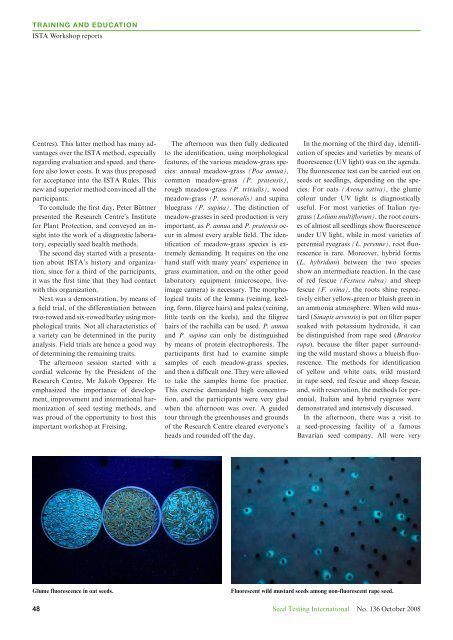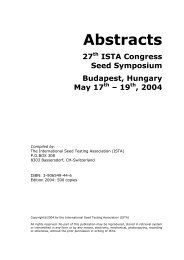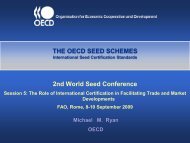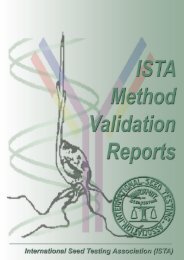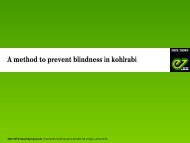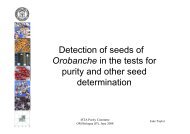(ISTA News Bulletin) No. 136, October 2008 - International Seed ...
(ISTA News Bulletin) No. 136, October 2008 - International Seed ...
(ISTA News Bulletin) No. 136, October 2008 - International Seed ...
Create successful ePaper yourself
Turn your PDF publications into a flip-book with our unique Google optimized e-Paper software.
Training and Education<br />
<strong>ISTA</strong> Workshop reports<br />
Centres). This latter method has many advantages<br />
over the <strong>ISTA</strong> method, especially<br />
regarding evaluation and speed, and therefore<br />
also lower costs. It was thus proposed<br />
for acceptance into the <strong>ISTA</strong> Rules. This<br />
new and superior method convinced all the<br />
participants.<br />
To conclude the first day, Peter Büttner<br />
presented the Research Centre’s Institute<br />
for Plant Protection, and conveyed an insight<br />
into the work of a diagnostic laboratory,<br />
especially seed health methods.<br />
The second day started with a presentation<br />
about <strong>ISTA</strong>’s history and organization,<br />
since for a third of the participants,<br />
it was the first time that they had contact<br />
with this organization.<br />
Next was a demonstration, by means of<br />
a field trial, of the differentiation between<br />
two-rowed and six-rowed barley using morphological<br />
traits. <strong>No</strong>t all characteristics of<br />
a variety can be determined in the purity<br />
analysis. Field trials are hence a good way<br />
of determining the remaining traits.<br />
The afternoon session started with a<br />
cordial welcome by the President of the<br />
Research Centre, Mr Jakob Opperer. He<br />
emphasized the importance of development,<br />
improvement and international harmonization<br />
of seed testing methods, and<br />
was proud of the opportunity to host this<br />
important workshop at Freising.<br />
The afternoon was then fully dedicated<br />
to the identification, using morphological<br />
features, of the various meadow-grass species:<br />
annual meadow-grass (Poa annua),<br />
common meadow-grass (P. pratensis),<br />
rough meadow-grass (P. trivialis), wood<br />
meadow-grass (P. nemoralis) and supina<br />
bluegrass (P. supina). The distinction of<br />
meadow-grasses in seed production is very<br />
important, as P. annua and P. pratensis occur<br />
in almost every arable field. The identification<br />
of meadow-grass species is extremely<br />
demanding. It requires on the one<br />
hand staff with many years’ experience in<br />
grass examination, and on the other good<br />
laboratory equipment (microscope, liveimage<br />
camera) is necessary. The morphological<br />
traits of the lemma (veining, keeling,<br />
form, filigree hairs) and palea (veining,<br />
little teeth on the keels), and the filigree<br />
hairs of the rachilla can be used. P. annua<br />
and P. supina can only be distinguished<br />
by means of protein electrophoresis. The<br />
participants first had to examine simple<br />
samples of each meadow-grass species,<br />
and then a difficult one. They were allowed<br />
to take the samples home for practice.<br />
This exercise demanded high concentration,<br />
and the participants were very glad<br />
when the afternoon was over. A guided<br />
tour through the greenhouses and grounds<br />
of the Research Centre cleared everyone’s<br />
heads and rounded off the day.<br />
In the morning of the third day, identification<br />
of species and varieties by means of<br />
fluorescence (UV light) was on the agenda.<br />
The fluorescence test can be carried out on<br />
seeds or seedlings, depending on the species.<br />
For oats (Avena sativa), the glume<br />
colour under UV light is diagnostically<br />
useful. For most varieties of Italian ryegrass<br />
(Lolium multiflorum), the root courses<br />
of almost all seedlings show fluorescence<br />
under UV light, while in most varieties of<br />
perennial ryegrass (L. perenne), root fluorescence<br />
is rare. Moreover, hybrid forms<br />
(L. hybridum) between the two species<br />
show an intermediate reaction. In the case<br />
of red fescue (Festuca rubra) and sheep<br />
fescue (F. ovina), the roots shine respectively<br />
either yellow-green or bluish green in<br />
an ammonia atmosphere. When wild mustard<br />
(Sinapis arvensis) is put on filter paper<br />
soaked with potassium hydroxide, it can<br />
be distinguished from rape seed (Brassica<br />
rapa), because the filter paper surrounding<br />
the wild mustard shows a blueish fluorescence.<br />
The methods for identification<br />
of yellow and white oats, wild mustard<br />
in rape seed, red fescue and sheep fescue,<br />
and, with reservation, the methods for perennial,<br />
Italian and hybrid ryegrass were<br />
demonstrated and intensively discussed.<br />
In the afternoon, there was a visit to<br />
a seed-processing facility of a famous<br />
Bavarian seed company. All were very<br />
Glume fluorescence in oat seeds.<br />
48<br />
Fluorescent wild mustard seeds among non-fluorescent rape seed.<br />
<strong>Seed</strong> Testing <strong>International</strong> <strong>No</strong>. <strong>136</strong> <strong>October</strong> <strong>2008</strong>


